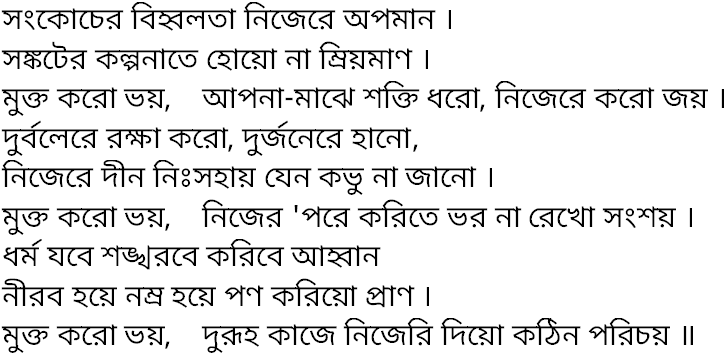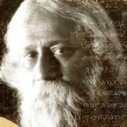Correct Pronunciation of Bengali alphabets: বাংলা বর্ণমালার নির্ভুল উচ্চারণ: Read the article⇗
The next version is coming soon.⇗
Rabindra Sangeet Albums. Sung by the verified singers of this website. 160 talented singers & over 850 songs.
Rabindra Sangeet Collections. Sung by the verified singers of this website. Nearly 500 unique Tagore songs.
Detail information about Rabindra Sangeet. All the lyrics, notations, background history with detail musical compositions, English translation and many more.
Lyric and background history of song sankocher biwhalata
Song of Rabindranath Tagore
This page contains lyric of Tagore song sankocher biwhalata and its transliteration in English with background history. Background of the song includes the place and date of the song written by Rabindranath, name of the newspaper or magazine the song was first published in and the name of the person who had prepared the notation or swaralipi. This page also contains the musical composition of song like parjaay, taal, raag and ango.
The other related elements of this song like translation in English and Hindi, notation in Bengali (swaralipi), staff notation (western) which are available in other pages, please find the related links below. We have also provided the pdf's of lyric, notation and staff notation with midi with downloadable links so that people may find it easier to get the song and notations in printed format.
Musical composition and background history of the song:
Parjaay: Swadesh (11)
Taal: Dadra
Raag: Iman-Kalyan
Written on: 1930 (10/9/1926)
Place: Hamburg
Swarabitan: 5
Notation by: Dinendranath Tagore
Notes: This song was written between 16th and 19th December, 1929.
A successful presentation of ‘Nobin’ at Shantiniketan as a part of Dol-purnima celebration in 1930 (1336B) had prompted to stage it once again at Kolkata. An exhibition of Japanese martial arts was annexed along with the program. On 16th of March, 1931 it was exhibited by Takagaki, the master from Japan and his students in Shantiniketan. This song was composed for the occasion. Nobin was enacted at New Empire for following four days from 17th to 20th March.
The new Arms act had prohibited Indian people to possess any kind of arms, not even a stick. Rabindranath was pleased to see the art of unarmed combat while his vist to Japan. He had made a contract and hence Takagaki had joined Shantiniketan in November, 1929 as the teacher of the art. The amount of his interest can be assessed from the fact that he had spent fourteen thousand rupees in two years on this account. However his endeavour had ended as futile for he could not inspire the middleclass lethargic youth and bashful young ladies of Bengal to learn the technique. The routine had been discontinued soon after Takagaki had returned to his country.
Roma Chakraborty, a contemporary student of Shantiniketan has depicted a picture in her book ‘Bhora Thaak Smritisudhay’ –
… In Shantiniketan training used to be provided for martial arts like Judo, fighting with sticks, daggar etc. Gurudev had deployed Takagaki, a qualified teacher for the Japanese martial arts or Ju-jitsu. This training was compulsory for the girls too. I must admit that hesitation and trepidation had gripped our mind, although it eased off with time and exposure. How easily Takagaki could throw a stout opponent off balance who fell flat in a moment – I still remember. Gurudev had learnt that girls are hesitant and composed this song ‘Sankocher bihwalata nijere apoman …’ – as I was told. …
Later the song was included in 'Chitrangada' with the first word 'Sankocher' replaced with 'Santrasher'.
Lyric in Bengali
All related links of this song
Download or print this lyric
Transliteration in English
Sankocher bihwabalata nijere apomaan. Sankater kalpanate hoyo na mriyomaan. Mukto karo bhay, aapona-maajhe shakti dharo nijere karo jay. Durbalere rokkha karo, durjanere haano, Nejere deen nihsahay jeno kabhu na jaano. Mukto karo bhay, nijer pare karite bhar na rekho sangshay. Dharmo jabe shankhorabe koribe aahwban Neerab hoye namra hoye pan koriyo praan. Mukto karo bhay, duruha kaaje nijeri diyo kothin porichay.
More about this song sankocher biwhalata
Get detail information about the song i.e. musical composition, background history, notation, translation and staff notation with downloadable options. Visit the following links.


